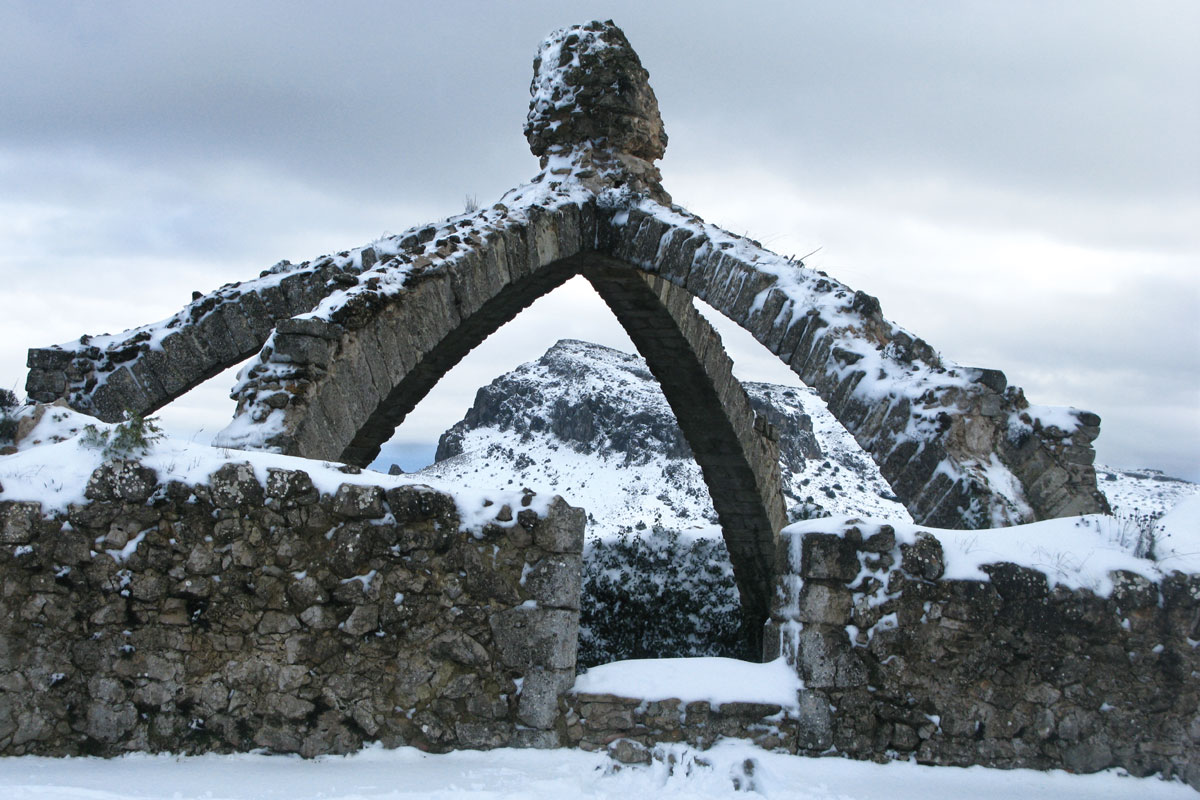
One of the most fascinating archaeological evidence of ancient use of Mediterranean mountains are snow pits, also called snow storehouses or snowdrifts. Scattered throughout the Iberian Peninsula, snow pits have become a clear evidence of much colder times, but, are we dealing with climate change or the evolution of natural cold and warm cycles?
It is probably difficult to clarify the reasons that explain this dense network of snow deposits built between the sixteenth and nineteenth centuries, as well as their location, which is sometimes very low, especially in light of current weather condition heights. Could we understand today that five tons of snow made into ice entered the city of Valencia daily, and all year round, from the snowdrifts of Bellida in Sacañet? Or that the deep pits of Mariola, Aitana, Benicadell or Port de la Carrasqueta were filled with snow to ensure ice supply to cities like Alzira, Xativa, Alcoi or Gandia? It is surprising at the very least, especially when we look at these buildings, their size and number in our mountains, which are sometimes very close to the sea.
Ice trade, economy and rural architecture
Snow pits were practical buildings that were built to preserve and save the snow collected during the winter and then distribute it according to need all year round until the nineteenth century. Its simple architecture –a large circular pit of variable depth, covered with masonry and roofing –hides a complex economic organization from collection and storage, to marketing. Deeply rooted in Mediterranean countries, historical texts talk about snow pits in ancient Greece and the Roman Empire, where snow was widely used for therapeutic purposes. And it seems these constructions were first built in the Iberian Peninsula with the arrival of Islam.

After the big winter snowfalls, once much more common and abundant, crews of men from the surrounding villages went up the mountains to bring snow to the snow pits for storage. While some took the snow to the pits, others worked inside the pit crushing it with wooden boards and making layers of straw, to compact it and turn it into ice. After this process was finished, the ice was cut into blocks and transported overnight to be delivered to the cities. Conservation of ice for several months in the snow pits was made possible through isolation which involved keeping a layer of cold air over the packed snow. Because this air was heavier, it allowed a constant cold temperature inside the wine cellar. The dome eased this isolation, since it completely covered the pit, either by using a cantilevering technique or cloister domes covered with tiles, which look similar to church domes, as in the case of the Arquejada snow pit in the Mariola mountains.
Snow pits were often built taking advantage of drops and small gaps, and they were dug at variable depth depending on the type of rock. Snow pits, with some exceptions, faced north and were built on shady slopes, near wind sheltered valleys where snow builds up, which made collection easier.
Ice was mainly used for three purposes: food preservation; healing, especially to alleviate fevers; and gastronomy, making ice cream, horchata (tiger nut milk) and cold drinks for the higher classes, which explains the ice cream tradition in some specific Alicante areas.
«Scattered throughout the Iberian Peninsula, snow pits have become a clear evidence of much colder times»
In the city of Valencia consumption of snow became general in the sixteenth century. It was popular to the point of being sold in the streets. Its widespread use for medical purposes resulted in the administration intervening in its distribution and trade to make sure the snow pits were properly exploited, since the ice trade had become an important source of income and, as a result, subject to taxation. Public snow pits were built to supply the most populated cities: Xàtiva, Gandia, Alzira, Castellon and Valencia, for example, and the towns rented them out to the highest bidder.
The climate change occurred between the seventeenth and eighteenth centuries, a period known as the Little Ice Age, colder and rainier, was final for the creation of an important network of snow pits and snowdrifts. Geographical and historical literature agree and the construction of snow pits at less than 800 meters, 28.7% of them, confirms this climate change. Its importance for economy became such that the Snow Pit Guild was established with its own set of rules. According to data provided by Jorge Cruz, in the eighteenth century Valencia consumed an average of 1,800 tonnes of snow, about 5,000 kilos daily.
With the advent of artificial ice factories in the late nineteenth century thanks to electricity, natural snow trade entered a period of crisis from which it never recovered. There is record of local consumption in Els Ports and Tinença de Benifassà until 1930, which completely disappeared only a few years later.
A distributed cultural heritage in the mountains
There remain three hundred snow pits in the region of Valencia, which constitute archaeological evidence of this phenomenon, unique in its proportions in the Iberian Peninsula. Undoubtedly, the physical conditions of the ancient kingdom of Valencia, with hot summers, a narrow coastal strip surrounded by mountains and fishing ports that needed ice to market the fish inland, contributed to the construction of this extensive network of snow storehouses. Of the thirteen existing snow pits in Serra de Mariola, there is a set that can be easily visited in addition to being the best preserved ones. La Cava de l’Habitació is found a few metres away from the mountain shelter of the Alcoi Hiking Centre, which can be accessed from Agres by walking along the marked trail that passes by the monastery of Agres or driving along the forest track. This snow pit is ten metres deep and seven metres wide and its capacity reaches 320 m3. It includes three windows or heads at the start of the dome built with stone and mortar. It has a retaining wall that is used as a buttress for the whole construction, since the pit has been dug in the mountainside itself.

Cava Arquejada has become the symbol of Serra de Mariola. In the picture we see it with Montcabrer peak at the background. /Picture: José Manuel Almerich
Following the track that runs from the shelter to Font de Mariola, about two hundred metres away from the crossroads, we arrive at the most beautiful and impressive of all existing snow pits in the region of Valencia, or at least the most famous one, Cava Arquejada or Cava Gran. It is located in a privileged spot overlooking the Montcabrer peak, one of the most representative images of this ancient economic activity, which is well known by hikers who come to Mariola. This snow pit is large, circular and its external layout is hexagonal. It has a capacity of 1,960 m3 and is twelve metres deep and almost fifteen metres wide. At the centre of the walls of the hexagon, there are six gates that reach 1.50 metres wide and two metres high approximately, although none of them preserves its lintel. On the edges of the hexagon there are six Gothic vaulting ribs that result in three round arches topped with a mortar piece. Its function was to support the wooden beams and tiled roof, which are already gone. Between 1923 and 1930 the dome was dismantled to repair the monastery of Agres and the beams themselves. Under the north gate, there is a vaulted tunnel that allowed access to horses that carried snow.
The Arquejada snow pit is the symbol of Mariola as well as a unique monument that should be protected by all means. An old road passes through the same platform and the risk of damage is very high, so it requires at least a steady consolidation of the architectural remains, a task that was started in our last visit.
«There remain three hundred snow pits in the region of Valencia, which constitute archaeological evidence of this phenomenon, unique in its proportions in the Iberian Peninsula»
One kilometre ahead, following the forest track, which remains at the same altitude, we can find Caveta del Buitre (The Volture Snow pit), after taking a different downward path only a few metres after leaving to our right the detour that leads to some aerials. Small in size, it has a capacity of 350 m3 and is 8.20 metres wide and 6.80 metres deep, dug in the ground. It has three upper windows from which the snow was introduced. It also has a small access tunnel to the gate of the pit. Visiting it is very interesting as it is in perfect condition and the roof remains intact. If we want to round off our snow pit tour with a visit to Cava de Don Miguel, whose outward appearance is rather like a fortress because of its monumentality and great proportions, we must continue along the main track until reaching a bend, only ten minutes from Caveta del Buitre, where the trail starts to descend towards Font de Mariola. At this point, we leave the track to take an evident and marked road to the right that runs westwards along the peak on the upper areas, going through rounded hills, until we reach the snow pit, after about 45 minutes walking. It is truly breathtaking as we approach it.

El Surdo snow pit, at the Port of Carrasqueta in Xixona (Alacantí). Casa del Nevater, beside the snow pit, is currently a rural hotel and restaurant. /Picture: José Manuel Almerich
Surrounded by a Cyclopean base which is forty metres wide, the pit was barely excavated because of the hardness of the limestone, so it was necessary to build eight huge octagonal buttresses and excellent ashlar masonry. It has three manholes located at different levels and a capacity of 1,700 m3 to store ice. In an outer ashlar we can read construction date: 1780. According to Jorge Cruz and Josep Maria Segura, in their book El comercio de la nieve (The Snow Trade), the location of the snow pit, almost at the top of the mountain in very windy area, prevented it from ever being completely full because in higher areas there isn’t usually enough snow to be gathered. It seems that the owner wanted it to be built here for prestige reasons, as the snow pit could be seen at night from the city of Valencia when a fire was lit. Cava de Don Miguel, like the others described here, was owned by the town of Xàtiva.
This set, probably the most representative of the Mediterranean mountains and which is easily accessed, as described above, allows us to appreciate the importance of this economic activity in Valencia. Other very impressive sets are the snow pit of la Bellida in Sacañet, the beautiful snowdrifts of Aitana or the wonderful snow store near the peak of Benicadell. These archaeological remains are proof of cooler and rainier periods, but we do not know for sure whether it is the action of climate change or cold cycles as previously mentioned. Today, due to scarce precipitation and higher temperatures, it would be impossible to fill these deposits and much less to sell ice, although it is true that their use declined with the advent of electricity.
From the little Ice Age to today

After the large winter snowfalls, which in the past were greater and more frequent, crews of men climbed the mountain to gather and store snow inside the snow pits. In the picture, a winter day in the town of Agres, in the Alicante region of El Comtat, where the steep streets look like a glacier. /Picture: José Manuel Almerich
The dense network of snow pits and their locations can be explained within the context of the so called Little Ice Age, which took place between the fourteenth and mid-nineteenth century, which marked the last glacial stage in many mountain areas of the planet. Historical references of heavy snow and famine as well as paleoclimatic studies testify to this. The same applies to the growth of alpine glaciers, which reached their maximum extent between the late seventeenth and early eighteenth century. Iceland saw a frozen sea at this time as well. This country holds a permanent exhibition on this period, as well as more familiar data for us such as the freezing of the Albufera and the River Ebro in November 1469, or heavy frosts in Castellon and Valencia. In 1829 we have data that the Albufera froze again and the River Ebro did so in 1709. Also heavy snowfall fell throughout the country where snow lasted more than fifteen days during this period.
The causes of these intense cold have been carefully studied by many scientists who point to periods of low solar activity, decrease in atmospheric transparency by increasing volcanic dust (large eruptions in Iceland) that would cause temperatures to drop. In short, whatever the reasons were, the fact is that this stage encouraged the construction of snow pits, many of which were built below 600 metres of altitude, as is the case of La Vall d’Albaida. Although these could have well been intermediate coolers or spots were to store the ice if the journey was long. These were known as supply snow pits.
«The wide distribution of snow pits could only have been possible with much more extreme climate conditions than today’s»
In short, we can conclude that the wide distribution of snow pits, their large number and location, sometimes at low altitudes, could only have been possible with much more extreme climate conditions than today’s. This cold that lasted for centuries developed the trade of snow making it a source of income, both for the inhabitants of the mountain villages and the tenants or pit builders, who were encouraged to start a business not free from tax, of course.
The question is whether the snow trade would have been possible without these climatic conditions and whether the Valencian society, who regarded snow as staple product, would have been able to get it.





